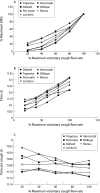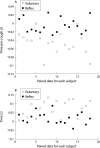Differences in motor activation of voluntary and reflex cough in humans
- PMID: 16601089
- PMCID: PMC2104707
- DOI: 10.1136/thx.2005.057901
Differences in motor activation of voluntary and reflex cough in humans
Abstract
Objectives: To study motor activation patterns of voluntary and reflex cough adjusted for cough flow rates.
Methods: Surface electromyography (EMG) and cough flow rate were measured in 10 healthy volunteers. Voluntary cough was assessed for 20 efforts in each quintile of increasing cough flow rate. Reflex cough was assessed for 25 efforts produced by nebulised l-tartaric acid. EMG was recorded over the expiratory (rectus abdominis, obliques, lower intercostals) and accessory (trapezius, pectoralis major, deltoid, latissimus dorsi) muscles. EMG activity, burst duration and onset were compared for each quintile of voluntary cough, and between voluntary and reflex cough matched for cough flow rate.
Results: EMG activity and burst duration of expiratory and accessory muscles during voluntary cough increased in proportion to cough flow. Expiratory muscles had longer EMG burst duration (difference 68 ms (95% CI 34 to 102), p<0.01) and earlier onset of EMG activity (difference 44 ms (95% CI 20 to 68), p<0.0001) compared with accessory muscles. EMG activity in all muscles was increased (mean 110.2% v 56.1%, p<0.001) and burst duration (mean 206 ms v 280 ms, p = 0.013) decreased in reflex cough compared with voluntary cough of equal flow rate. There were no differences in EMG onset (difference 8 ms (95% CI 25 to -9) or burst duration (difference 27 ms (95% CI 58 to -4) between expiratory and accessory muscles.
Conclusions: Functional organisation of motor activity differs between voluntary and reflex cough. Voluntary cough is characterised by sequential activation whereas reflex cough is associated with early and simultaneous activation of expiratory and accessory muscles.
Conflict of interest statement
The authors have no financial, academic or personal conflicts of interest to report.
Similar articles
-
Expiratory function in complete tetraplegics: study of spirometry, maximal expiratory pressure, and muscle activity of pectoralis major and latissimus dorsi muscles.Am J Phys Med Rehabil. 1999 Sep-Oct;78(5):464-9. doi: 10.1097/00002060-199909000-00009. Am J Phys Med Rehabil. 1999. PMID: 10493457
-
Respiratory muscle activation and action during voluntary cough in healthy humans.J Electromyogr Kinesiol. 2019 Dec;49:102359. doi: 10.1016/j.jelekin.2019.102359. Epub 2019 Sep 24. J Electromyogr Kinesiol. 2019. PMID: 31568991
-
Developing control algorithms of a voluntary cough for an artificial bioengineered larynx using surface electromyography of chest muscles: A prospective cohort study.Clin Otolaryngol. 2018 Apr;43(2):562-566. doi: 10.1111/coa.13022. Epub 2017 Nov 23. Clin Otolaryngol. 2018. PMID: 29069534
-
Before we get started: what is a cough?Lung. 2008;186 Suppl 1:S3-6. doi: 10.1007/s00408-007-9036-8. Epub 2007 Oct 2. Lung. 2008. PMID: 17909894 Review.
-
Urge-to-cough: what can it teach us about cough?Lung. 2008;186 Suppl 1:S107-11. doi: 10.1007/s00408-007-9045-7. Epub 2007 Oct 22. Lung. 2008. PMID: 17952695 Review.
Cited by
-
Intra-abdominal pressures during voluntary and reflex cough.Cough. 2008 Apr 30;4:2. doi: 10.1186/1745-9974-4-2. Cough. 2008. PMID: 18447952 Free PMC article.
-
Perspective on the human cough reflex.Cough. 2011 Nov 10;7:10. doi: 10.1186/1745-9974-7-10. Cough. 2011. PMID: 22074326 Free PMC article.
-
Acoustic Analysis of Voluntary Coughs, Throat Clearings, and Induced Reflexive Coughs in a Healthy Population.Dysphagia. 2023 Dec;38(6):1467-1486. doi: 10.1007/s00455-023-10574-1. Epub 2023 May 28. Dysphagia. 2023. PMID: 37245187 Free PMC article.
-
Cough expired volume and airflow rates during sequential induced cough.Front Physiol. 2013 Jul 5;4:167. doi: 10.3389/fphys.2013.00167. eCollection 2013. Front Physiol. 2013. PMID: 23847546 Free PMC article.
-
Semantics and types of cough.Pulm Pharmacol Ther. 2009 Apr;22(2):139-42. doi: 10.1016/j.pupt.2008.12.008. Epub 2008 Dec 25. Pulm Pharmacol Ther. 2009. PMID: 19136069 Free PMC article.
References
-
- Leith D E, Butler J P, Sneddon S L.et al Cough. In: Handbook of physiology: the respiratory system. Volume III, Part 1. Bethesda: American Physiological Society, 1990315–336.
-
- Korpas J, Widdicombe J G. Aspects of the cough reflex. Respir Med 199185(Suppl A)3–5. - PubMed
-
- Addington W R, Stephens R E, Gilliland K A. Assessing the laryngeal cough reflex and the risk of developing pneumonia after stroke: an interhospital comparison. Stroke 1999301203–1207. - PubMed
Publication types
MeSH terms
LinkOut - more resources
Full Text Sources
Other Literature Sources
Medical



